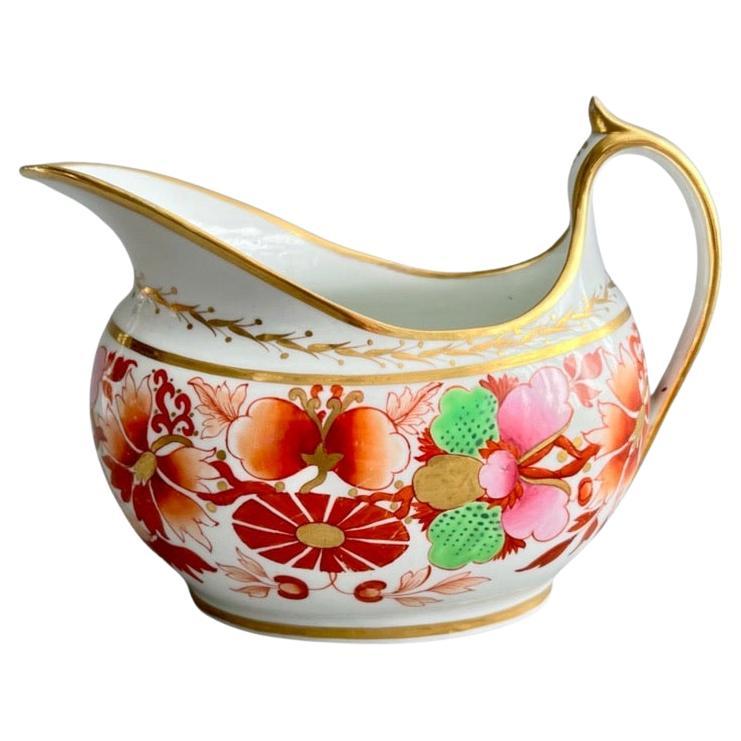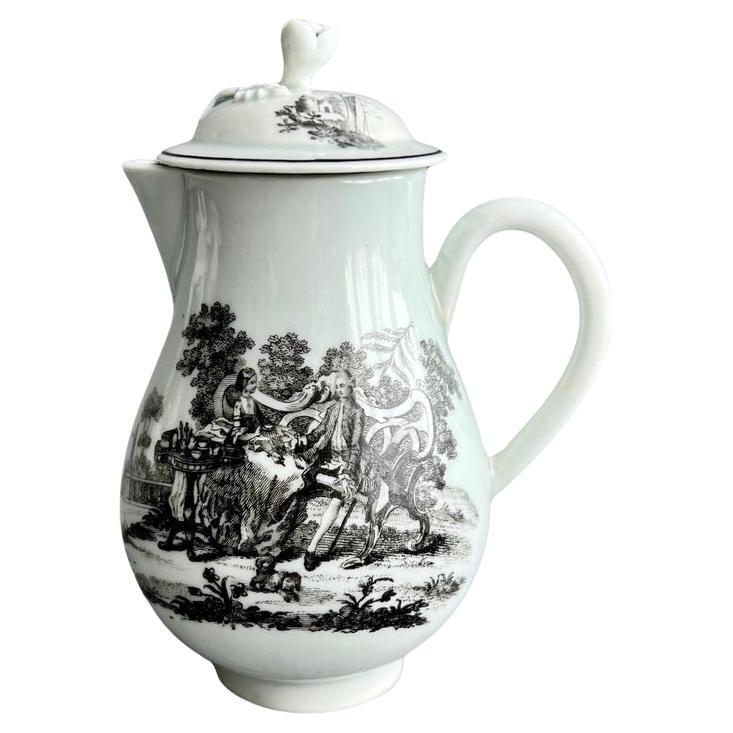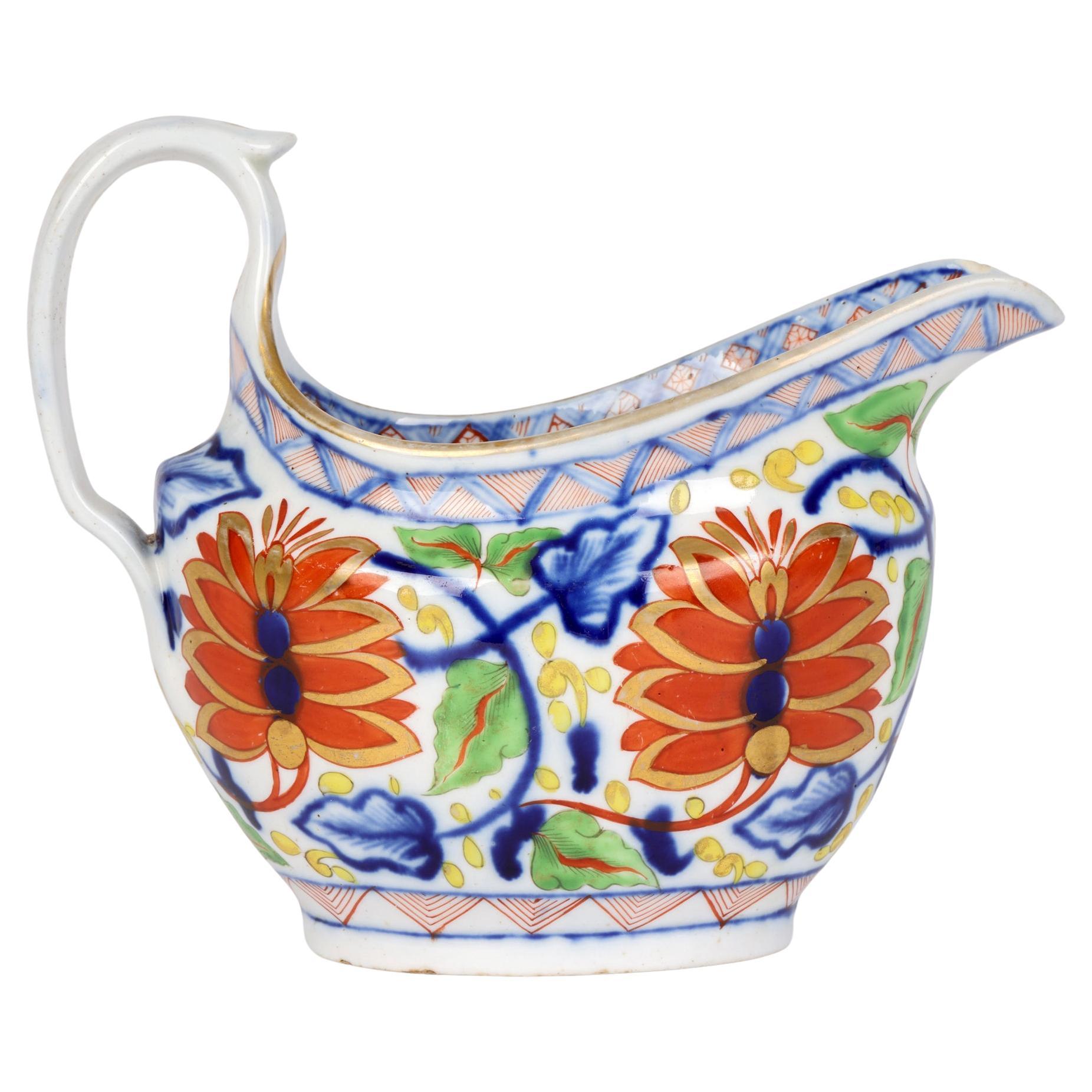Minton Porcelain Creamer Milk Jug, Neoclassical Imari, Regency, ca 1810
About the Item
- Creator:Minton (Maker)
- Dimensions:Height: 4.75 in (12.07 cm)Width: 6 in (15.24 cm)Depth: 3 in (7.62 cm)
- Style:Regency (Of the Period)
- Materials and Techniques:
- Place of Origin:
- Period:
- Date of Manufacture:circa 1810
- Condition:Wear consistent with age and use. In perfect antique condition without any damage, crazing or repairs and only minimal wear.
- Seller Location:London, GB
- Reference Number:
Minton
Pottery is one of the oldest decorative art forms, and Minton is one of its historical masters. For more than 250 years, the English company was a premier producer of porcelain and ceramic wares. Its factory was known for detailed and brightly colored Victorian tableware, including dinner plates and serving pieces.
Thomas Minton founded the Minton factory in 1793 in Stoke-upon-Trent, England. It initially made earthenware but introduced bone china in 1798. When Minton died in 1836, the company passed to his son, Herbert Minton. The younger Minton was a savvy businessman with an eye for design. He introduced glossy majolica earthenware to the factory’s repertoire and hired skilled artists and designers like Augustus Welby Northmore Pugin and Albert-Ernest Carrier-Belleuse, boosting the company’s reputation.
In 1851, Minton debuted its majolica at the Great Exhibition in London. It became a royal family favorite and was even used to tile the Royal Dairy at Windsor Home Park. Minton majolica was also displayed on the monumental Saint George and the dragon fountain at the 1862 London International Exhibition.
Colin Minton Campbell, a nephew of Herbert Minton, took over the family business in 1858. He led the company to the head of the 1870s English art pottery movement. In the 1890s, French porcelain artist Marc-Louis Solon helped modernize Minton with his Art Nouveau designs.
Minton ceased operating as an independent company when it merged with Royal Doulton Tableware Ltd. in 1968. It was the end of an era, but not the end of widespread appreciation for Minton ceramics.
In 1982, the ”English Majolica” exhibition at the Cooper Hewitt, Smithsonian Design Museum featured 75 Minton pieces. When the Metropolitan Museum of Art reopened its British Galleries in 2020, it included a display of three colorful Minton majolica bird sculptures. Minton pottery was also on display from September 2021 to January 2022, along with other English pottery, at the Bard Graduate Center’s ”Majolica Mania” exhibition.
On 1stDibs, find exquisite Minton serveware, decorative objects, wall decorations and more.
- ShippingRetrieving quote...Ships From: London, United Kingdom
- Return PolicyA return for this item may be initiated within 14 days of delivery.
- Barr Flight & Barr Milk Jug / Creamer, Regency Imari Pattern, ca 1810By Barr, Flight & Barr WorcesterLocated in London, GBThis is a colourful milk jug or creamer made by Barr Flight & Barr around the year 1810. It is decorated with a bright Imari design in the Regency taste. This milk jug would have be...Category
Antique 1810s English Regency Porcelain
MaterialsPorcelain
- Spode Milk Jug Creamer, Cobalt Blue Neoclassical Pattern Imari, Regency Ca 1825By SpodeLocated in London, GBThis is a beautiful milk jug or creamer made by Spode around 1825. The jug is decorated in a beautiful Neoclassical pattern in Imari colours and has a characteristic serpent handle. ...Category
Antique 1820s English Regency Porcelain
MaterialsPorcelain
- Ridgway Porcelain Milk Jug, White with Purple Flowers, Regency, circa 1825By Ridgway PorcelainLocated in London, GBThis is a charming milk jug or creamer made circa 1825 by Ridgway. The jug is decorated with simple monochrome puce / purple flowers on a white ground. The shape is typical for its t...Category
Antique 1820s English Regency Pitchers
MaterialsPorcelain
- Worcester Milk Jug and Cover, Creamer, Monochrome Print Tea Party no.2, ca 1760By 1st Period Worcester Dr. WallLocated in London, GBThis is a very charming milk jug with cover made by Worcester in their First Period (sometimes called the Dr Wall Period) in about 1760. The items are decorated in a black overglaze ...Category
Antique 1760s English George III Porcelain
MaterialsPorcelain
- Spode Porcelain Teacup, Imari Tobacco Leaf Pattern 967, Regency ca 1810By SpodeLocated in London, GBThis is a beautiful teacup and saucer made by Spode in about 1810. The set is decorated with the famous Imari Tobacco Leaf pattern 967, which was first introduced by Spode in 1806. ...Category
Antique 1810s English Regency Porcelain
MaterialsPorcelain
- Spode Porcelain Teacup Trio, Red Imari Dollar Pattern, Regency, ca 1810By SpodeLocated in London, GBThis is a beautiful orphaned teacup made by Spode in about 1810. It bears a beautiful Japanese-inspired Imari pattern. Spode was the great pioneer among the Georgian potters in England. Around the year 1800 he perfected the bone china recipe that has been used by British potters ever since, and he was also the leading potter behind the technique of transferware, making it possible for English potters to replace the Chinese export china, which had come to an end around that time, with their own designs. This was fundamental to a thriving industry that would last for about 150 years and provide half the world with their tableware. Spode porcelain is regarded as one of the highest quality porcelains around; for a soft-paste porcelain it is surprisingly hard and fine, and has a wonderful bright white colour. The pattern on this can is called "Dollar" pattern, a very famous pattern that was used by English potters in the 18th and early 19th Century. It is obvious why it is called “dollar” - but its origin is less obvious! It is thought that this pattern was derived from a very old Chinese pattern depicting a tree with elaborate foliage that hides a Chinese character representing longevity or happiness. Traditionally, this went with a an image called “Taotie”, which was used on very ancient bronze vases...Category
Antique Early 1800s English Regency Porcelain
MaterialsPorcelain
- English Porcelain London Shape Imari Painted JugBy Coalport PorcelainLocated in Bishop's Stortford, HertfordshireA fine quality antique English porcelain, possibly Coalport, London shape sauce jug decorated in an Imari pattern and dating from around 1810. The sauce jug is lightly potted and is ...Category
Antique Early 19th Century English George III Pitchers
MaterialsPorcelain
- Antique English Caughley Porcelain Milk Pitcher or JugBy Caughley PorcelainLocated in Philadelphia, PAA fine antique English porcelain milk pitcher or jug. Comprising the pot, a conforming lid, and a later associated chain connecting the two. With blue underglaze decoration of...Category
Early 20th Century English Georgian Pitchers
MaterialsPorcelain
- Set of 2 pcs. German Meissen Porcelain Cream and Milk Pitchers / JugsBy Meissen PorcelainLocated in Vilnius, LTSet of 2 pcs. of German Meissen porcelain cream and milk pitchers / jugs. Porcelain is white, glazes and hand painted with rich gold decor. The logo marked on the bottoms. Dimensions...Category
Mid-20th Century German Porcelain
MaterialsGold
- Antique English Staffordshire Transferware Serving Creamer Jug PitcherLocated in Dayton, OH"Antique 20th century Staffordshire transferware porcelain jug or pitcher featuring an English landscape in black, originally designed by James Cutts for W. Adams & Sons, and a yellow border around the upper edge. “James Cutts was born in 1808 in Pinxton, Derbyshire, he was the 9th of 10 children and the youngest of five boys. His father, John Cutts, was a moderately gifted china painter, trained at the Derby porcelain works, who moved to become manager of the Pinxton porcelain...Category
Early 20th Century Late Victorian Porcelain
MaterialsPorcelain
- Ridgway Porcelain Milk Jug or Creamer Pattern 2/1005, Regency Period, circa 1825By J & W RidgwayLocated in Lincoln, LincolnshireThis is a very decorative, porcelain milk jug or creamer in the early Grecian shape, made by John and William Ridgway, of Shelton, Hanley, Staffordshire Potteries, England, dating to...Category
Antique Early 19th Century English Regency Ceramics
MaterialsPorcelain
- Antique Staffordshire Porcelain Lilac Sprig Decorated JugLocated in Bishop's Stortford, HertfordshireA very fine antique English Staffordshire porcelain jug decorated with lilac sprigged floral designs and dating from around 1830. The jug is finely made in white porcelain and is of ...Category
Antique 1830s English Regency Pitchers
MaterialsPorcelain






